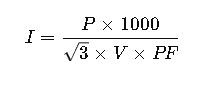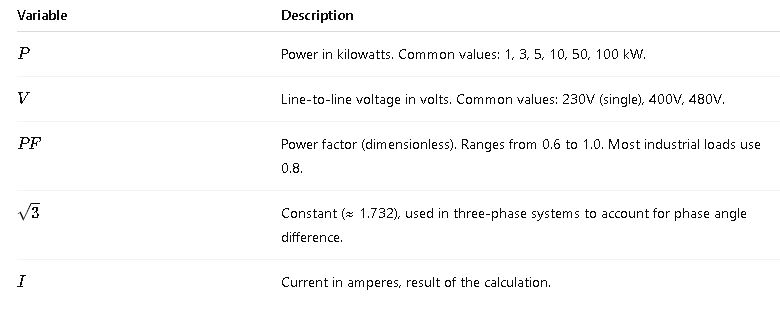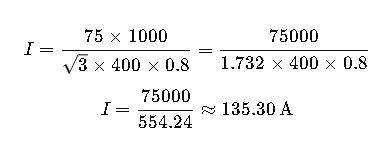Convert kW to amps: kW×1000 ÷ (√3·V·PF) = Current, instantly explained.
Use our free calculator — one click, precise results, slash wiring costs today.
kW to Amps Calculator
• 1 kW ≈ a domestic microwave.
• 22 kW ≈ a medium EV charger.
Tip: kW is what you pay for on your energy bill, not kVA. ? Single‑phase AC – homes (120 V US, 230 V EU).
Three‑phase AC – industry, EV fast chargers; smoother motors.
DC – batteries, solar arrays, telecom 48 V.
Select the option that matches your installation. ? Popular voltages:
• 120 V – US household (L‑N)
• 230 V – EU household (L‑N)
• 400 V – EU three‑phase (L‑L)
• 48 V – DC solar strings
If yours is different, pick “Other” and type it. ? Power factor (PF) = kW ÷ kVA (0 to 1).
• 1.00 – resistive heaters.
• 0.95 – modern LED drivers.
• 0.85 – premium‑efficiency motors.
• 0.70 – old pumps, welders.
Low PF wastes energy → utilities may bill penalties.
Improve with capacitor banks or VFDs.
Example
18 kW · 400 V · three‑phase · PF 0.85 → I = 18 000 / (√3×400×0.85) = 30.63 A
FAQ
What is power factor?
Real/apparent‑power ratio. Motors ≈ 0.8–0.9, resistive ≈ 1.
Why does current change with voltage?
Higher voltage → lower current, reducing conductor size and losses.
AC vs DC formulas?
DC: I = kW×1000/V. Three‑phase AC adds √3 and PF.
Related calculators
Extensive Tables of kW to Amps Conversion Values
The following tables provide practical reference values for converting kilowatts (kW) to amperes (A) under both single-phase and three-phase systems. These values assume common voltages (230V, 400V, 480V, etc.) and power factors.
Note: Amperes depend on voltage and power factor (PF). Tables assume PF = 0.8 (typical for industrial applications).
Table 1: Single-Phase kW to Amps (230V, PF = 0.8)
| Power (kW) | Voltage (V) | Power Factor | Amps (A) |
|---|---|---|---|
| 0.5 | 230 | 0.8 | 2.71 |
| 1 | 230 | 0.8 | 5.43 |
| 2 | 230 | 0.8 | 10.87 |
| 3 | 230 | 0.8 | 16.30 |
| 5 | 230 | 0.8 | 27.17 |
| 7.5 | 230 | 0.8 | 40.76 |
| 10 | 230 | 0.8 | 54.35 |
| 15 | 230 | 0.8 | 81.52 |
| 20 | 230 | 0.8 | 108.69 |
| 25 | 230 | 0.8 | 135.86 |
Table 2: Three-Phase kW to Amps (400V, PF = 0.8)
| Power (kW) | Voltage (V) | Power Factor | Amps (A) |
|---|---|---|---|
| 1 | 400 | 0.8 | 1.80 |
| 2 | 400 | 0.8 | 3.61 |
| 5 | 400 | 0.8 | 9.03 |
| 7.5 | 400 | 0.8 | 13.54 |
| 10 | 400 | 0.8 | 18.03 |
| 15 | 400 | 0.8 | 27.05 |
| 20 | 400 | 0.8 | 36.07 |
| 25 | 400 | 0.8 | 45.08 |
| 30 | 400 | 0.8 | 54.10 |
| 50 | 400 | 0.8 | 90.17 |
| 75 | 400 | 0.8 | 135.25 |
Table 3: Three-Phase kW to Amps (480V, PF = 0.8)
| Power (kW) | Voltage (V) | Power Factor | Amps (A) |
|---|---|---|---|
| 1 | 480 | 0.8 | 1.50 |
| 2 | 480 | 0.8 | 3.01 |
| 5 | 480 | 0.8 | 7.52 |
| 10 | 480 | 0.8 | 15.04 |
| 15 | 480 | 0.8 | 22.56 |
| 20 | 480 | 0.8 | 30.08 |
| 30 | 480 | 0.8 | 45.12 |
| 50 | 480 | 0.8 | 75.20 |
| 75 | 480 | 0.8 | 112.80 |
| 100 | 480 | 0.8 | 150.40 |
kW to Amps Conversion Formulas and Variable Definitions
Single-Phase System
Where:
- I: Current in amperes (A)
- P: Power in kilowatts (kW)
- V: Voltage in volts (V)
- PF: Power Factor (typical values: 1 for resistive loads, 0.8 for inductive)
Three-Phase System
Explanation of Variables:
Common Power Factor Values
| Load Type | Power Factor |
|---|---|
| Resistive (heaters) | 1.0 |
| Motor (light load) | 0.6–0.75 |
| Motor (full load) | 0.8–0.9 |
| Capacitive loads | 0.95–1.0 |
| Industrial equipment | 0.8 (typical) |
Real-World Application Examples
Example 1: Sizing a Generator for a Water Pump
Problem:
An agricultural engineer needs to select a generator for a 10 kW water pump, operating at 230V single-phase, with a power factor of 0.85.
Solution:
Use the single-phase formula:
Interpretation:
- The generator must provide at least 51.13 A of continuous current at 230V.
- A generator rated at 60 A would be a safe choice.
Example 2: Industrial HVAC Installation
Problem:
An HVAC system rated at 75 kW, powered by a three-phase 400V system, with a power factor of 0.8, needs proper breaker sizing.
Solution:
Interpretation:
- A circuit breaker rated at 150 A or higher is recommended, considering startup current.
Voltage Standards and Regional Considerations
When designing or analyzing electrical systems, voltage standards vary globally. Accurate kW to Amps conversion requires knowledge of these common nominal voltages:
| Region | Single-Phase Voltage | Three-Phase Voltage |
|---|---|---|
| North America | 120V / 240V | 208V / 480V / 600V |
| Europe | 230V | 400V |
| Asia | 220V / 230V | 380V / 400V / 415V |
| Australia | 230V | 400V |
| South America | 220V / 240V | 380V / 440V |
Note: Always verify the actual voltage at the installation point, as utility tolerances and specific setups may differ.
Electrical Code Compliance and Design Considerations
NEC Guidelines for Ampacity
According to the National Electrical Code (NEC), wire and breaker sizing must be based on continuous current plus a safety margin (typically 125%). For example:
This ensures protection against overheating and allows for minor overcurrents during startup.
Wire Sizing
After calculating amps, wire size must be selected based on ampacity tables like NEC Table 310.16. For example:
| Current (A) | Copper Wire Size (AWG) | Aluminum Wire Size (AWG) |
|---|---|---|
| 15 | 14 | 12 |
| 20 | 12 | 10 |
| 30 | 10 | 8 |
| 50 | 6 | 4 |
| 100 | 3 | 1 |
| 150 | 1/0 | 2/0 |
Always consider derating factors for ambient temperature and number of conductors in conduit.
Power Factor Correction in Industrial Systems
In industrial settings, low power factor results in higher current, increasing losses and utility charges. Converting kW to amps without correcting the PF can lead to oversized equipment. Solutions include:
- Capacitor banks: Improve PF from 0.75 to 0.95+
- Synchronous motors: Operate at leading PF to offset inductive loads
Example:
For a 50 kW motor at 480V three-phase:
- At PF = 0.75:
- At PF = 0.95 (after correction):
Reduction: ~21% less current — saving energy, reducing conductor size, and minimizing voltage drop.
Advanced Real-World Case Study: Data Center UPS Sizing
Scenario:
A data center is installing a 150 kW Uninterruptible Power Supply (UPS) operating at 480V three-phase with 0.9 power factor. The engineer must determine the input current.
Calculation:
Additional considerations:
- Design the circuit breaker for at least 250 A
- Use copper cables (likely 250–300 MCM)
- Include 20% extra capacity for redundancy and scalability
Useful Tools and External Resources
To assist with real-time calculations and equipment sizing, the following tools and standards are recommended:
- NEC Wire Ampacity Tables – National Fire Protection Association
- Schneider Electric kW to Amps Tool
- ABB Electrical Engineering Calculator Suite
- IEEE Std 141 – Red Book – Power Distribution Reference
Common Errors to Avoid in kW to Amps Conversion
| Mistake | Why it’s a Problem | Recommendation |
|---|---|---|
| Ignoring power factor | Results in underestimating current | Always include PF in calculations |
| Using line-to-neutral voltage | Applies only in certain systems (Wye) | Use line-to-line for 3Φ systems |
| Not applying √3 in 3Φ systems | Understates current by ~42% | Always use full formula |
| Omitting startup/load margin | Equipment may trip on startup | Use 125% safety factor |
| Incorrect voltage assumption | Regional differences can cause major errors | Verify actual system voltage |
Summary: Why Accurate kW to Amps Conversion Matters
Correctly converting kilowatts to amps is not just a mathematical exercise—it’s essential for:
- System safety: Prevents overheating, fire hazards, and breaker trips
- Cost efficiency: Avoids over-sizing and under-sizing of equipment
- Regulatory compliance: Meets NEC and IEC standards
- Operational reliability: Supports uptime in critical installations
Understanding and applying the formulas, variables, and real-world considerations ensures optimal electrical system performance across residential, commercial, and industrial settings.








